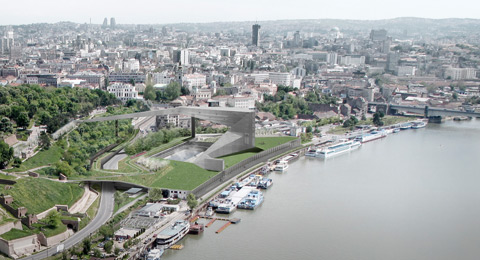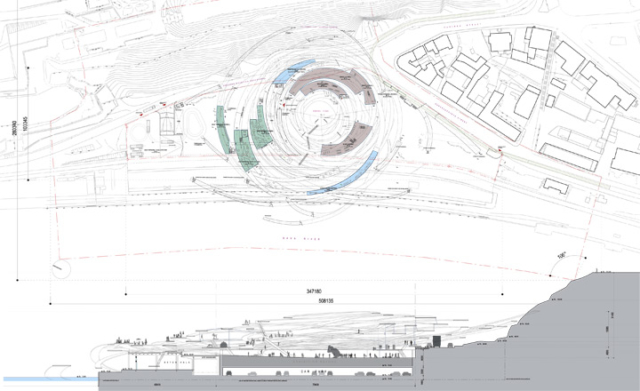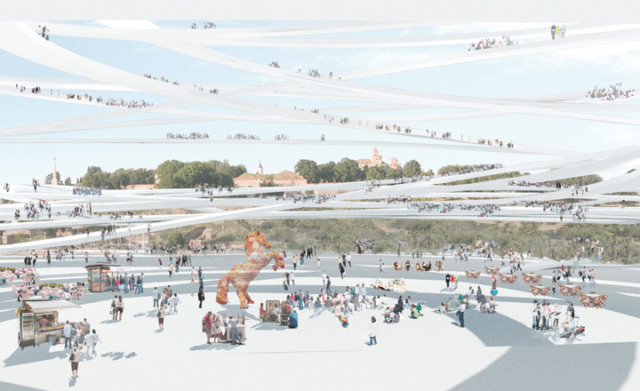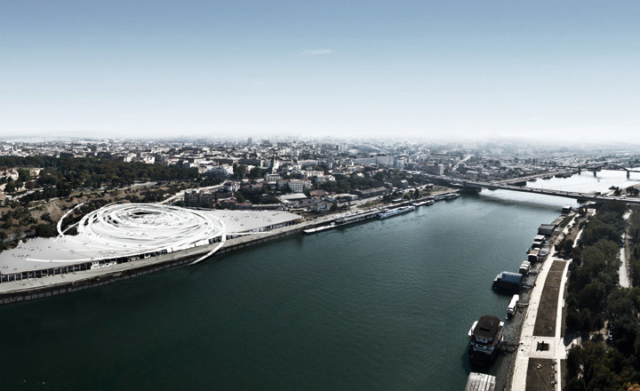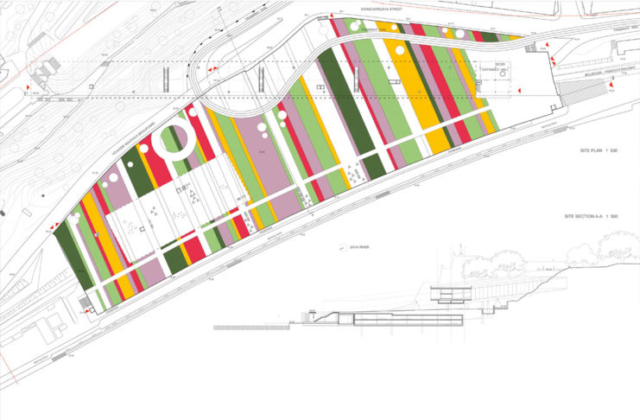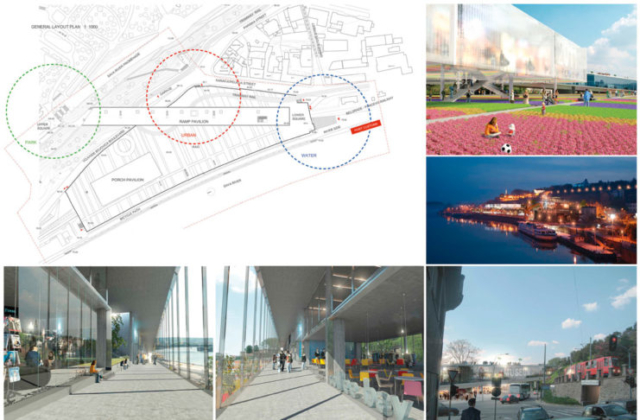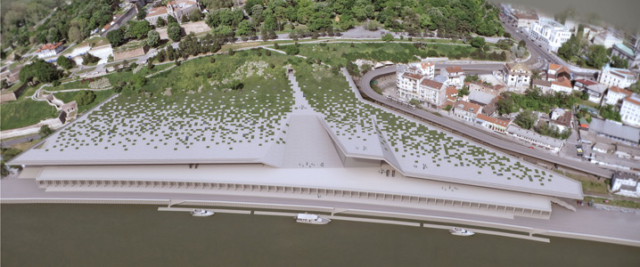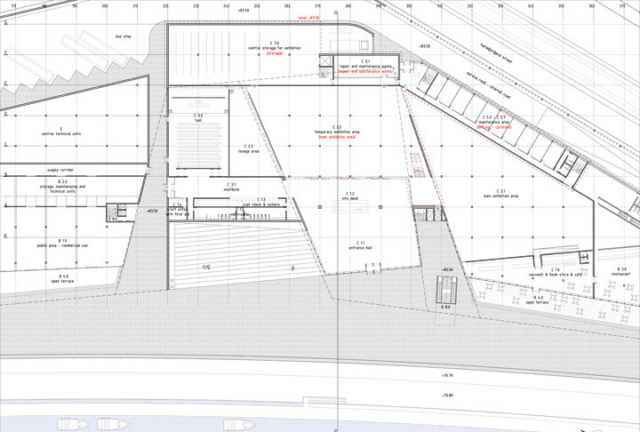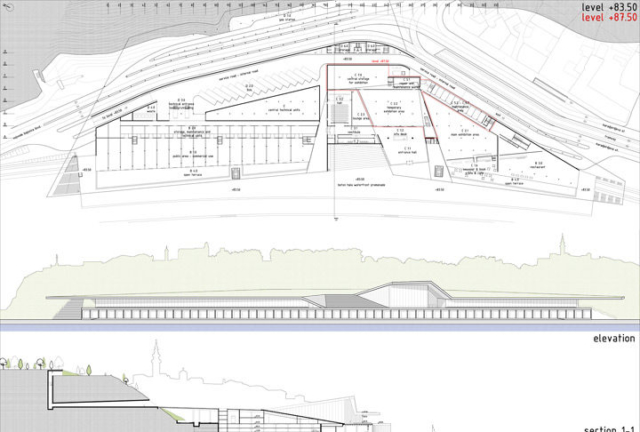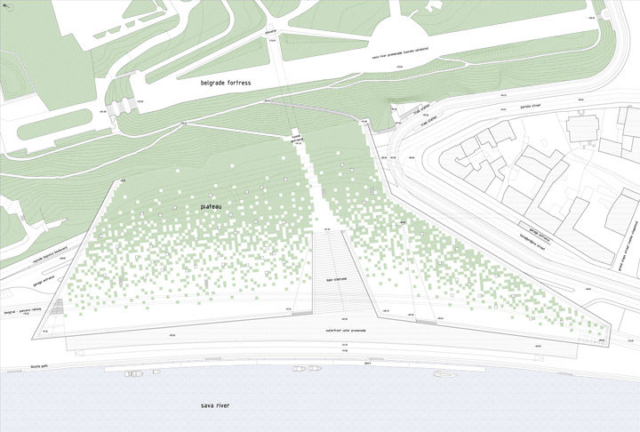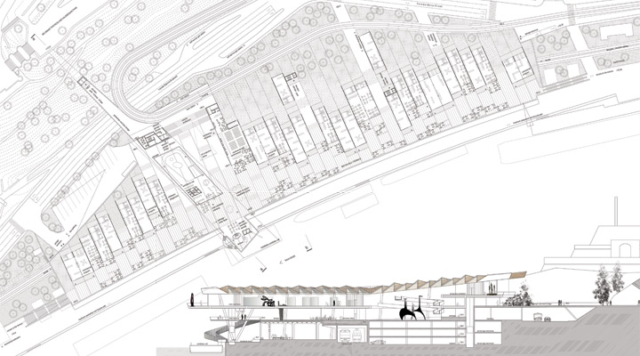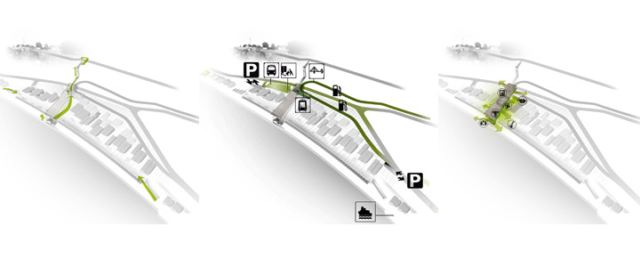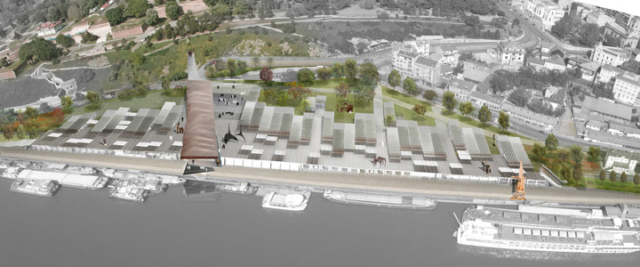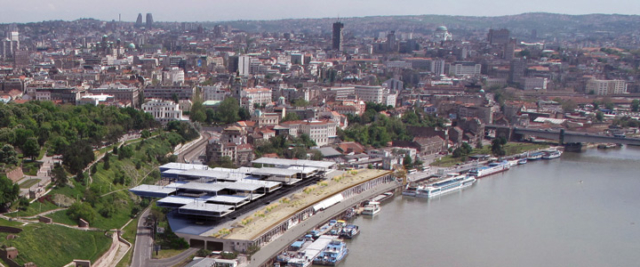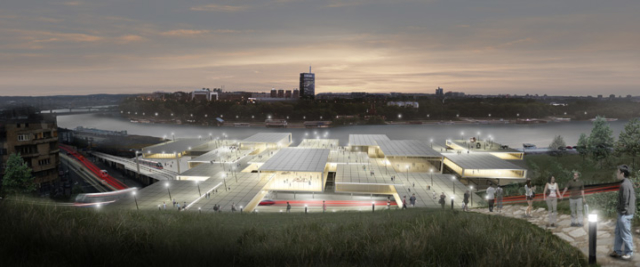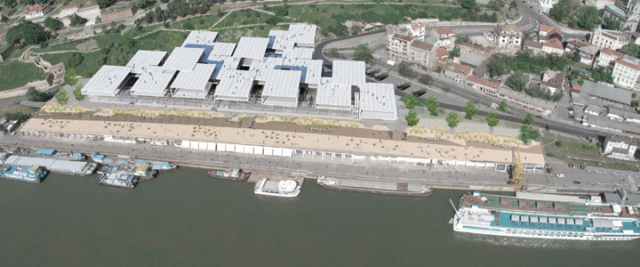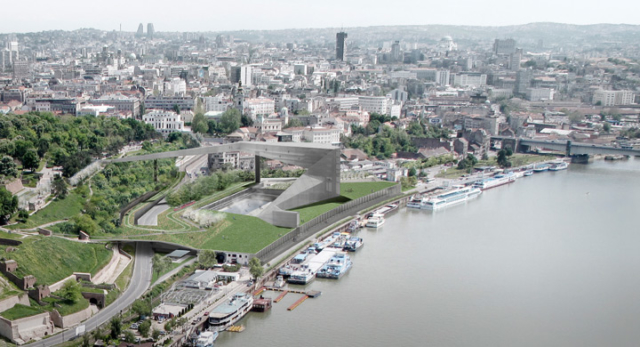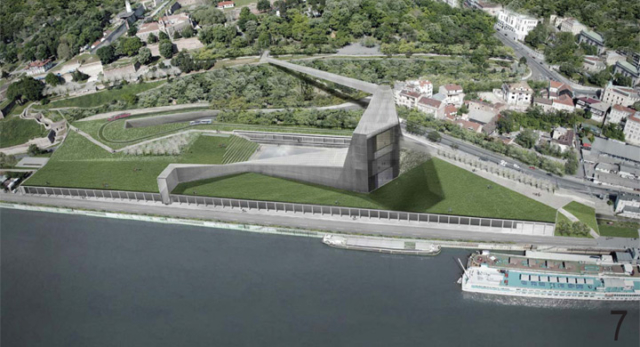Nedavno završeni konkurs za izradu arhitektonsko-urbanističkog rešenja Beton Hale u Beogradu, koju možemo očekivati u skorijoj budućnosti, je pravo osveženje za priču o arhitekturi Beograda. Mi smo se ovoga puta odlučili da Vam prikažemo nagrađene radove, kao i neke od radova koji nisu nagrađeni ali su se dopali nama, pa verujemo da će se dopasti i Vama.
Sou Fujimoto Architects
Jednakovredna prva nagrada
OBLAK
Centar 21. veka sličan je oblaku gde kontinuitet i celovitost koegzistiraju.
Naš predlog za Beton halu – Waterfront centar je centar u vidu oblaka koji povezuje Beton halu, Beogradsku tvrđavu, Kalemegdanski park, reku Savu, pristanište trajekta, tramvajsku stanicu, autobusku stanicu i gradsku zonu, i ujedinjava komercijalne i izložbene prostore u jednu celinu.
Centralni trg, čiji oblik definiše most/staza, povezuje okolne zone i označava, u istorijskom trenutku, oblak budućnosti nastao od zidina bele tvrđave – iz prošlosti.
Spiralna forma mosta/staze prostire se od okolnih repernih tačaka i infrastrukture, ujedinjujući tako različite elemente, i omogućava pristup komercionalnim i izložbenim prostorima.
Prsten predstavlja Srbiju.
ARCVS
Branislav Redžić, Dragan Ivanović, Zoran Milovanović, Zoran Đorović, Vesna Milojević, Boris Husanović, Marko Todorović, Predrag Stefanović
Jednakovredna prva nagrada
Ovo rešenje se izdvojilo od ostalih konkursnih radova time što je ponudilo jednostavnu, ali prefinjenu kompleksnost. Kada se posmatraju sa Novog Beograda i sa mosta, novi prostori na fini način ističu istorijski sklop Kalemegdana ne narušavajući njegovu elegantnu siluetu. Krov u raznim bojama i pun cveća, zapravo peta fasada objekta, obogaćuje pogled sa brda i otvara njegovo prostranstvo za razne urbane namene. Vešto kombinovani, dvofunkcionalni volumeni obrazuju arhitektonsko telo projekta i asociraju na raznolikost ekspresije svakodnevnog života Beograda, visoki nivo fleksibilnosti koja prihvata i poziva na dalji razvoj i kvalitetne promene.
Dejan Miljković-Jovan Mitrović-Aleksandar Rodić
Treća nagrada
Glavna ideja koja stoji iza predloženog dizajna novog Waterfront centra jeste definisanje važanog repera u ovom jedinstvenom delu grada zadržavajući suštinu Beogradske tvrđave i postojeće Beton hale i putem dodavanja savremenih elemenata koji će delovati kao veza između tvrđave i rečne obale.
Posebna pažnja je posvećena istorijskom značaju i prirodnom okruženju ove oblasti i novi centar predstavlja značajan revitalizujući objekat za ovaj deo grada koji pruža prijatan prostor i interesantan sadržaj za građane Beograda i posetioce.
Dizajn i uređenost novog Waterfront centra čine ga jedinstvenim mestom za razne beogradske dnevne aktivnosti i njegov intenzivan noćni život.
Linija fronta iznad postojeće Beton hale sadrži sve komercijalne elemente uključujući i prestižne kulturne, gastronomske aktivnosti i aktivnosti zabave, stvarajući tako dodatnu obalnu stazu i pešačku zonu koje su namenjene svima da u njima uživaju.
Važna karakteristika predloženog projekta je da su i njegova funkcionalnost (unutrašnji prostor) i estetika (plato na vrhu) fleksibilni i omogućavaju promene tokom vremena, kako nastaju nove potrebe. Iz tog razloga centar je projektovan, koliko je moguće, minimalistički, da bude dugotrajan i ekonomski efikasan.
Posebna pažnja je usmerena na ideju da objekat bude ekološki prihvatljiv i održiv, i da predstavlja koristan arhitektonski dodatak svom okruženju.
MX_SI architectural studio
Uslovi lokacije (razlike u nivoima, infrastrukturni putevi i sama zgrada Beton hale) će biti zadovoljeni na jedan jasan i efektan način, koji će istovremeno promovisati kulturno-umetnički identitet kompleksa.
Kulturni objekat namenjen za izložbe postaje glavni učesnik i organizator novih urbanih dogadjaja. Ovaj novi objekat održava i podržava identitet kulturnih kompleksa i predstavlja sebe kao novi infrastrukturni reper. Kulturni objekat je dovoljno vidljiv sa nižeg pešačkog nivoa na obali reke, i posetioci mogu biti usmereni na njega, jer se objekat spoznaje takođe kao nova komunikacija sa višim nivoima.
U izuzetno važanom u urbanom kontekstu, projekat pristupa problemu razmere na veoma suptilan način. S jedne strane, projekat se ne nadmeće sa prisustvom Kalemegdanske tvrđave, niti sa Beton halom. Sa druge strane, on nikada ne gubi svoju reprezentativnost. Intervencija naglašava male i rasute paviljone, pre nego velike volumene koji bi mogli da poremete postojeći ambijent. Najveći predloženi volumen (Kulturni kran sa izložbenim prostorom) je konfigurisan u vidu terasa – umetničkih platoa, elementa koji su izuzetno horizontalni i inače prisutni u širem području – reke i veliki izgrađeni infrastrukturni reperi: mostovi, skladište Beton hala i Kalamegdanska tvrđava, koji stoje oko lokacije u harmoničanom odnosu.
Komercijalni i servisni sadržaj je organizovan u paviljonima od jedne do dve etaže čija je razmera podešena u odnosu na gradsku strukturu, i na taj način su izbegnute nepotrebne velike strukture velikih tržnih centara.
SADAR + VUGA
Predlogom za kompleks Waterfront centar utvrđena su tri javna gradska nivoa: (1)Beton hala, (2)Plaža i (3)Šetalište (Esplande), svaki sa jedinstvenim karakterom i ambijentom. Šetalište pre svega predstavlja plato namenjen protoku ljudi. Putanje kretanja na platou deluju kao produžetak krivudavih staza Kalemegdana koje silaze do reke, a njihov karakter apstraktanog, kontemplativanog, slobodanog i otvorenog prostora nadovezuje se na atmosferu Novog Beograda. Na krovu Beton hale, peščana površina i platforma za sunčanje čine novi prostor za centar grada Beograda koji nudi urbanu plažu, slobodan i javan prostor za odmor i rekreaciju. Tvrđava je vidljiva i dostupna preko parking prostora koji se prostire na više nivoa. Ispod njega, postojeći nivo šetališta uz obalu reke i Beton hale zadržava svoj karakter sa pešačkom i biciklističkom stazom i “binom” ispred barova, restorana i prodavnica smeštenih unutra.
Nivo šetališta (Esplande) sastoji se od niza isprepletanih kutija. Kutije imaju iste dimenzije, osim visine koja zavisi od upotrebe unutrašnjeg prostora. One su pozicionirane i povezane na takav način da omogućavaju funkcionalnu organizaciju unutrašnjeg prostora, kontinuirano kretanje preko šetališta, i prodor svetla i vidika kroz strukturu. One daju dinamičan oblik zgradi koja se vidi sa svih strana. Prozračnost i lakoća su glavne karakteristike forme i materijalizacije zgrade.
Kutije orijentisane ka reci imaju velike terase i omogućavaju vidike na plažu ispod, mostove na reci Savi i na Novi Beograd na drugoj strani. Veličina ovih terasa varira u odnosu na sadržaj unutar kutije. To su polu-javni prostori namenjeni za bašte restorana, terase za sunčanje, pauze za ručak i kafu i za nadkrivene izložbe na otvorenom.
ABDArchitetti
botticini de appolonia e associati
Iskorišćenost celokupnog raspoloživog prostora lokacije sa funkcionalnim dvo-etažnim podzemnim objektom definise novi veštački prostor, park, koji zatvara sistem postojećih parkovskih površina na obali reke Save i integriše većinu zahteva programa konkursa, ostavljajući oblast bez gradjevina. Jedini artefakt iznad podzemnog dela predstavlja veoma skulpturalan objekat koji omogućava vezu između nižih i viših nivoa područja.
Predložena su dva različita funkcionalna bloka: dvo-etažni podzemni deo sa više funkcionalnih zona koje su definisane u raspisu konkursa (parking, autobuska stanica, zona utovara, tehničke zone i skladišta), i u njegovom jezgru, deo sa restoranima, galerijama, prodavnicama, razvijen oko novoprojektovanog trga.
Nadzemni objekat se uzdiže od ozelenjenog nivoa i sadrži sve funkcije navedene u konkursnim uslovima za izložbeni prostor: dva velika izložbena prostora (privremena i stalna postavka) servisni prostori, administracija, lobi, foaje, sala za konferencije, knjižara, kafe (dve poslednje navedene funkcije povezane su na nivou trga).
Srce nove Beton hale – Waterfront centra, predstavlja trg sa specifičnim detaljima zamišljen ne samo kao povezujuća zona između različitih funkcija, koja ga definiše kao prazan prostor, već uglavnom kao mesto gde ljudi mogu da se sastaju i okupljaju za razliku od dinamičnijeg sadržaja koji se može naći u spoljašnjim zonama u blizini fronta Beton hale i “objekta-puta”.
Recently completed competition for architectural and urban solutions for the Concrete Hall in Belgrade, the realization of which can be expected in the near future, is an invigorating event on the architectural scene of Belgrade. Therefore, we have decided to present award-winning projects, as well as some of the non-rewarded ones which we found interesting, and we hope you will find them appealing too.
Sou Fujimoto Architects
Equal first prize
CLOUD
21st century hub is akin to a cloud where continuity and totality co-exist.
Our proposal for the Beton Hala Waterfront Centre is a cloud-like hub, which connects Beton Hala, Fortress, Kalemegden Park, Sava river, the ferry terminal, tram, bus and urban district, unifying commercial and exhibition spaces as a whole
The central plaza shaped by the bridge/path connects the surroundings, and marks in a historical moment; the cloud of the future, born from the border of white castle walls (past).
This spiral form of the bridge/path extends from the surrounding points and infrastructure, unifying the various elements and provides access to the commercial and exhibition spaces.
A ring representing Serbia.
ARCVS
Branislav Redžić, Dragan Ivanović, Zoran Milovanović, Zoran Đorović, Vesna Milojević, Boris Husanović, Marko Todorović, Predrag Stefanović
Equal first prize
This scheme stood out form the rest of competitors by offering a simple, but refined complexity. Viewed from Novi Belgrade and from the bridge, new spaces gracefully underline the skyline of historic Kalemegdan, without competing with its elegant silhouette. Colorful, flowery treatment of the roof, the veritable fifth façade of the project, enriches the view from the hill and offers its immense space to variety of urban uses. Skillfully combined, two functional volumes constitute architectural body of the project and hint at the variety of expressions of everyday life of Belgrade, high level of flexibility which invites and accepts evolution and healthy change.
Dejan Miljković-Jovan Mitrović-Aleksandar Rodić
Third prize
The main idea behind the proposed design of the new Waterfront Center is to make an important landmark in this distinctive part of town by keeping the essence of the Belgrade Fortress and the existing Beton Hala and adding contemporary elements which will act as a connection between the Fortress and the river bank.
The historic significance and the natural surroundings of the area have been given particular attention and the new centre provides an important reviving building for this part of town, offering a pleasant space and interesting contents for Belgrade’s citizens and visitors.
The design and arrangement of the new Waterfront Center creates a unique point for Belgrade’s various daily activities and its vibrant night life.
The front line above the existing Beton Hala contains all the commercial elements including the prestigious cultural, gastronomic and entertainment activities, creating an extra waterfront walkway and pedestrian area for everyone to enjoy.
An important feature of the proposed design is that both its functionality (internal space) and aesthetics (top level plateau) are flexible and allow changes through time as new needs arise. For that reason the centre has been designed to be as minimalist as possible, to be age proof and economically efficient.
Great attention has been taken to make the building environmentally friendly and sustainable and to be a benefiting architectural addition to its surroundings.
MX_SI architectural studio
Amount of borders on the site (level differences, infrastructural roads and the building of Beton-hala itself) will be over crossed in one clear and strong way, which at the same time will promote the cultural-artistic identity of the complex.
The cultural building hosting the public-exhibitions becomes the main character and organizer of the new urban operation. This new building maintains and enhances the identity of the cultural complex and presents itself as a new infrastructure landmark. The cultural building is visible enough from the lower riverside at pedestrian level, and visitors can be directed to it since it can be recognized also as a new connection to upper levels.
In an extremely important urban context, the project approaches the scale problem in a very subtle manner. In one hand, the project does not compete with Kalemegdan fortress presence, neither with Beton-hala. In the other hand, it never looses its representativity. The intervention emphasizes small and dispersed pavilions rather than big volumes than could interfere with existing landscape. The largest volume proposed (Cultural Crane hosting the exhibition space) is configured as terraces – art plateaus, elements that are extremely horizontal and present in the wider area – the rivers and big built infrastructure landmarks: bridges, Beton-hala warehouse and Kalamegdan fortress are standing up around the site in harmonic relationship.
The commercial and service program is organized in one to two stories pavilions adjusting its scale to the city structure, avoiding unnecessary shopping-mall big structures.
SADAR + VUGA
With this proposal for the Waterfront Center complex three public urban levels are established: (1)Beton hala, (2)the Beach and (3)the Esplanade, each with a unique character and ambience. The Esplanade is first and foremost a circulation plateau. Trajectories of movement on the Esplanade act as an extension of Kalemegdan’s winding paths down to the river, while its character of an abstract, contemplative, free and open space relates to the atmosphere of New Belgrade. On the roof of Beton Hala, the sandy surface and sunbathing deck create a fresh space for Belgrade’s city center to offer – an urban beach, a free and public leisure and recreation space. The Fortress is visible and accessible through the multi-storey car park. Underneath it, the existing level of the riverbank promenade and Beton Hala keeps its current character with the pedestrian and bicycle path and the “stage” in front of the bars, restaurants and shops housed inside.
The Esplanade level consists of a series of interwoven boxes. The boxes are all the same dimension, but different heights according to usage inside. They are positioned and connected in such a manner as to allow for a functional interior organization, continuous movement on the Esplanade, and light and vista penetrations through the structure. They create the dynamic form of the building seen from all sides. Permeability and lightness are main characteristics of the building’s form and mater.
Boxes oriented towards the river offer large balconies and vistas to the Beach below, the bridges on Sava River and New Belgrade on the other side. The size of these terraces varies, based on the program inside the box. These are semi-public spaces intended for restaurant gardens, sunbathing terraces, lunch and coffee breaks, and open-air covered exhibitions.
ABDArchitetti
botticini de appolonia e associati
Amount of borders on the site (level differences, infrastructural roads and the building of Beton-hala itself) will be over crossed in one clear and strong way, which at the same time will promote the cultural-artistic identity of the complex.
The cultural building hosting the public-exhibitions becomes the main character and organizer of the new urban operation. This new building maintains and enhances the identity of the cultural complex and presents itself as a new infrastructure landmark. The cultural building is visible enough from the lower riverside at pedestrian level, and visitors can be directed to it since it can be recognized also as a new connection to upper levels.
In an extremely important urban context, the project approaches the scale problem in a very subtle manner. In one hand, the project does not compete with Kalemegdan fortress presence, neither with Beton-hala. In the other hand, it never looses its representativity. The intervention emphasizes small and dispersed pavilions rather than big volumes than could interfere with existing landscape. The largest volume proposed (Cultural Crane hosting the exhibition space) is configured as terraces – art plateaus, elements that are extremely horizontal and present in the wider area – the rivers and big built infrastructure landmarks: bridges, Beton-hala warehouse and Kalamegdan fortress are standing up around the site in harmonic relationship.
The commercial and service program is organized in one to two stories pavilions adjusting its scale to the city structure, avoiding unnecessary shopping-mall big structures.


